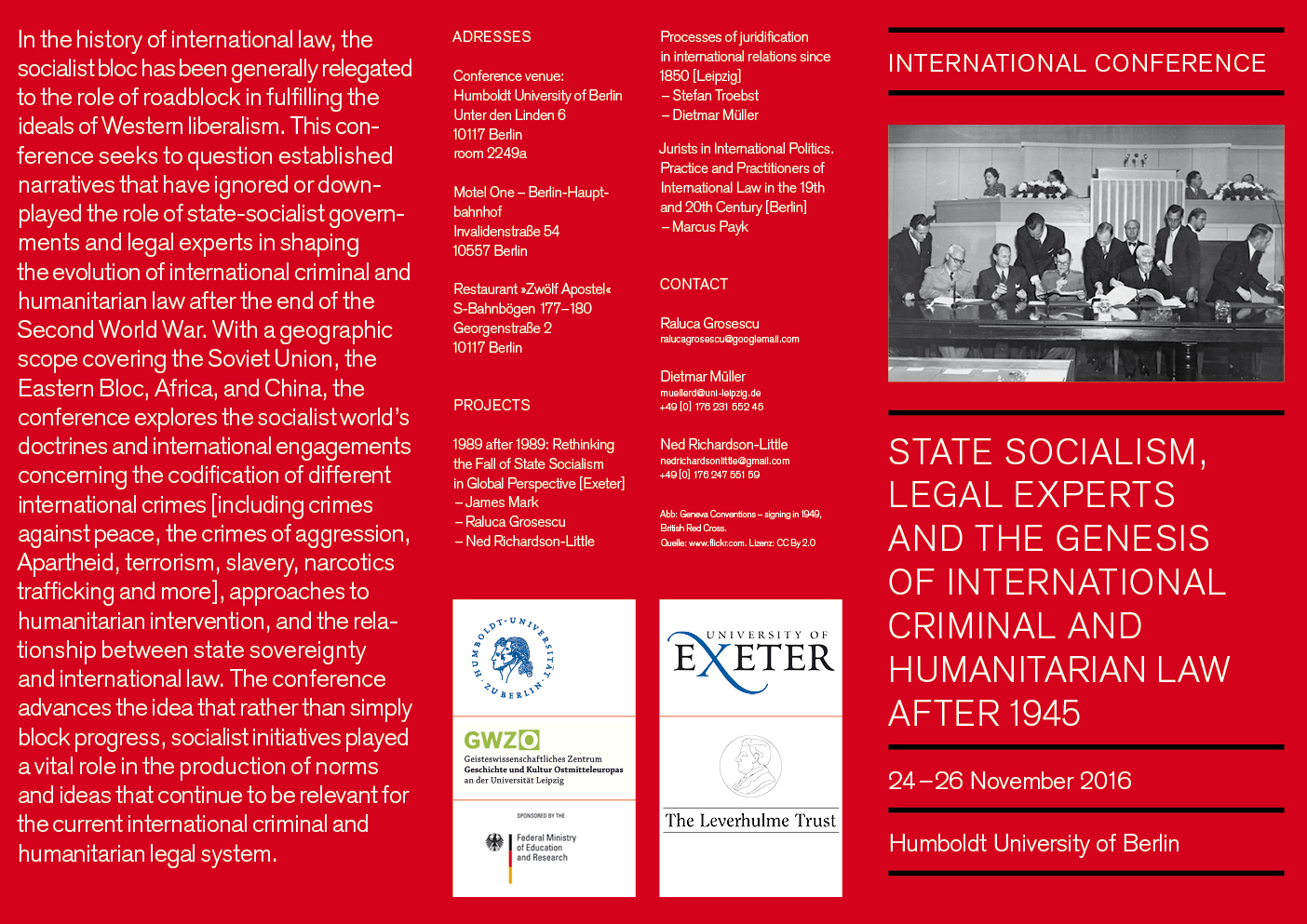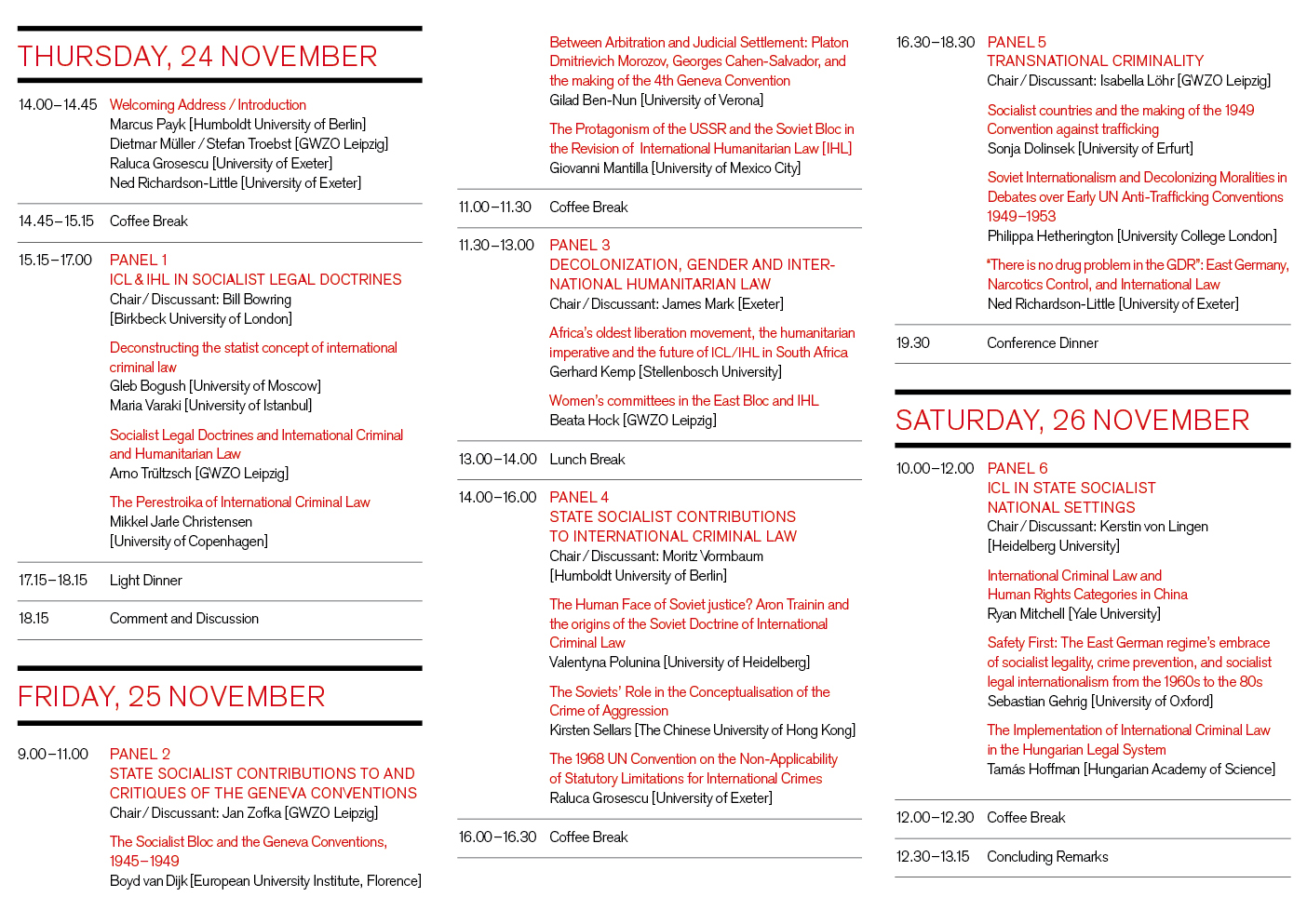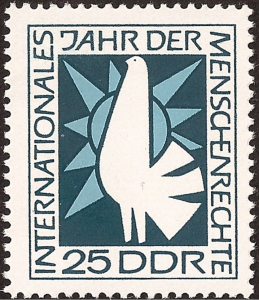State Socialism & International Criminal & Humanitarian Law after 1945 Conference Programme
Posted on 15 November, 2016 in1989 after 1989 Eastern Europe International Criminal Law International Humanitarian Law Socialism South Africa Transitional justice

State Socialism, Legal Experts and the Genesis of International Criminal and Humanitarian Law after 1945
November 24-26, 2016
 Conference Venue:
Conference Venue:
Humboldt University of Berlin
Unter den Linden 6
10117 Berlin
Room 2249a
The programme for our international collaborative conference with the Leipzig Centre for the History and Culture of East-Central Europe (GWZO), and the Humboldt University of Berlin is now available. It will take place on the 24-26 November, 2016 at Unter den Linden 6, Room 2249a, Humboldt University of Berlin, Germany.
It brings together 3 research projects – 1989 after 1989, Processes of Juridification in International Relations since 1850 based at Leipzig and Jurists in International Politics Practice and Practitioners of International Law in the 19th and 20th Century based in Berlin.
Conference Synopsis
In the history of international law, the socialist bloc has been generally relegated to the role of roadblock in fulfilling the ideals of Western liberalism. This conference seeks to question established narratives that have ignored or downplayed the role of state-socialist governments and legal experts in shaping the evolution of international criminal and humanitarian law after the end of the Second World War. With a geographic scope covering the Soviet Union, the Eastern Bloc, Africa, and China, the conference explores the socialist world’s doctrines and international engagements concerning the codification of different international crimes (including crimes against peace, the crimes of aggression, Apartheid, terrorism, slavery, narcotics trafficking and more), approaches to humanitarian intervention, and the relationship between state sovereignty and international law. The conference advances the idea that rather than simply block progress, socialist initiatives played a vital role in the production of norms and ideas that continue to be relevant for the current international criminal and humanitarian legal system.
The conference commences at 14:00 on the 24 November with a welcome address and introduction from the conference organisers – Marcus Payk, Humboldt University of Berlin; Dietmar Mueller and Stefan Troebst, GWZO Leipzig; Raluca Grosescu, University of Exeter and Ned Richardson-Little, University of Exeter. Papers will then be presented that deal with International Criminal Law and International Humanitarian Law in socialist legal doctrines.
Panels on the following day will include papers on state socialist contributions to and critiques of the Geneva Conventions; decolonisation, gender, and International Humanitarian Law, state socialist contributions to International Criminal Law; and Transnational Criminality. The final day will debate International Criminal Law in state socialist national settings and will include case studies from China and Hungary.
To register your interest in attending this conference please contact Raluca Grosescu and Dietmar Mueller
More information on the conference can be found on our conference pages.
Minsk as a Townscape of The Belarusian Power
Posted on 25 February, 2015 in1989 after 1989 Post-Soviet Cities

By Nelly Bekus
Cityscape of Minsk embodies the imaginary environment of the Belarusian power as a legitimate successor of the socialist state.
“If Soviet cities had looked like Minsk today, Soviet Union would have survived,” is probably one of the most indicative opinions I’ve ever heard from the visitors of the Belarusian capital. It is rather problematic to say to which extent it captures the hypothetical fortune of the Soviet state, but what it certainly does is reveal aspirations that inform the capital formative politics of the Belarusian leadership.
Any state can be viewed as a performative collective actor, which both reproduces and has been reproduced through banal processes, which enforce the symbolic presence of state across all kinds of social practices and relations and which help to sustain connection between the state and the people via the concept of belonging. Any capital city is assigned a particular role in displaying and channeling the nation’s image and idea. Yet, in country like Belarus the pressure on capital’s symbolic importance not even doubles, but triples. The country’s newborn national statehood, its centralized political system, and its vastly meaningful socialist legacy, material and non-material alike, facilitate maintaining the hegemony of power in various spheres of peoples’ life. Belarus turned to be particularly apt to preserve and develop the Soviet pattern of the symbolic-ideological design of state, reproducing the matrix of the “spectacular state” in the nationstate framework. A wide range of various civil rituals and social practices has been developed on the micro- and macro-levels of everyday life of the Belarusians, which aim at symbolic reification of the Belarusian idea, as understood by ideologists. Minsk, no doubt, has been assigned a particular role in the performative strategy of the Belarusian state.
Favourable National Framework for the Socialist Legacy
After the failure of state socialism the capital cities of the new independent states had to formulate new principles of their urban development. For many countries, the model to follow became the “Western city,” as an attribute of European civilization, the winner of the Cold War. The consequences of cities’ development in that direction (socio-spatial stratification, suburbanization, gentrification, automobilization, etc.) were perceived as natural and even desirable products of the changing pattern of urbanism. The socialist legacy of cities associated with the outdated system came to be perceived as unwanted inheritance. Micro-districts that once embodied the idea of egalitarian society have now become the most decaying areas in cities.
Against this background, Minsk appears to be a rare exception. The status granted to its socialist legacy in the new national cityscape and the logic of its cooperation with the nation-state ideology puts Belarus outside of Eastern European liberal affinity. The primary metaphor of the Belarusian official discourse defining post-communism has become the idea of a seamless continuation of the Soviet tradition. From the beginning of his presidency, the Belarusian President A. Lukashenko has chosen strategy of exploiting the nostalgic feelings of one part of Belarusian society, and he did so for a good reason. The last decade of the state socialism often depicted as “Soviet decay” seemed contrary to the lived experience of most Belarusians. It was not stagnation, but the years of rapid economic development and improvement of the lifestyle of the majority.
Minsk as a Soviet Artefact
The major structural changes in Belarus took place after the Second World War. Minsk as the capital of the Republic of Belarus was also the product of Soviet vintage. Minsk experienced massive destruction during the Second World War, it was the third most demolished city after Berlin and Warsaw. 80% of city infrastructure and 70% of pre-war housing stock of the city were destroyed.
According to the conception of master plan of Minsk (1946), new city was designed to combine the image of a “true capital of the Soviet Socialist republics” with the function of a large industrial center. The combination of striking parade monumentalism, patriotic art decoration and traditional motifs has become the most characteristic feature of the central avenues of Minsk. In late 1950s, when quasi-pragmatic period of socialist architecture had begun with its shift to the wide use of standardized construction, the center of Minsk had been surrounded by a belt of simplistic buildings made of pre-fabricated concrete, gradually passing into the clone-like “sleeping areas” of late socialism. The image of city soon became dominated by buildings that provided modest accessible housing for everybody due to a rapid construction of classless neighborhoods.
In the 1960s, when the construction of the monumental image of the city center was almost complete, Soviet authorities undertook an action for the ideological design of Minsk. A mythology of the partisan movement as the specific “Belarusian” contribution to a common victory in the Great Patriotic War became a key element of the Soviet Belarusian historical narrative, immediately reflected in a corresponding symbolization of public spaces in Minsk. The status of “Hero City” was given to Minsk in 1974. In addition, several important monuments were dedicated to World War II: Victory square with the eternal flame in front of the obelisk in the city center; Yama Memorial (the Ditch), dedicated to the commemoration of 800 000 Belarusian Jews—victims of the Holocaust; and a memorial on the site of the Nazi concentration camp Trastsianets. The Belarusian Great Patriotic War Museum in Minsk became the first museum in Belarus, opened in 1944, even before the war was over. In 1966 it was relocated to Oktiabrskaya Square, next to the building of the Central Committee of Communist Party of BSSR (the Presidential Palace since 1994).
The mythology so attentively composed by Soviet ideologists for Belarusians outlived the Soviet state itself. It became a key element of the national narrative about heroic collective deeds. In contrast to the Soviet narrative, the new discourse nationalizes the Belarusians’ heroic fight against the Nazi occupiers during World War II. The emphasis has been put not on the fraternal struggle of Soviet people against invaders, but on the Belarusians’ effort in liberation of their land. In a similar fashion, the general perception of Sovietness has been “Belarussified.”The Soviet period is now described as a period of formation of the contemporary Belarusian nation.
The Soviet legacy, solidified and materialized in the center of Minsk, appears to be a fairly relevant reflection of the official view on the formation of the Belarusian nation. The Sovietness of Minsk’s city center has the same functional meaning of “historical heritage” that all European countries invest in their capitals. In old European cities the preservation of the historical center has meant the creation of a kind of reservoir of national cultural tradition, molded into architectural form. The history encoded in the architectural monumentality of the Stalinesque center of Minsk refers to the Soviet era, but it has been attributed the same symbolic meaning. In 2004, Belarusian authorities nominated Minsk’s central avenue for inclusion on the UNESCO World Heritage List (avenue’s name in Soviet times— Stalin Avenue, from 1961—Lenin Avenue, from 1991—Frantishak Skaryna Avenue, and, finally, since 2004 till present time—Independence Avenue). The cultural legacy, represented by the remarkably solid and stylistically homogeneous urban architectural ensemble of central Minsk, has been presented as evidence of the Soviet contribution to the formation of the Belarusian nation. In the spirit of this memory politics, not only have all Soviet monuments kept their place and symbolic meaning in Minsk’s public space (including the Lenin statue on Independence Square) but new monuments commemorating events and characters related to the Soviet past have also been built during the years since independence. A Feliks Dzierzhinski statue was installed in Minsk in 2006—a memorial to the founder of the Soviet NKVD, though there was a Dzierzhinsky monument in Minsk, built in the Soviet era near Independence Avenue. Several new monuments were built on the wave of the nationalization of the memory of World War II, such as the “Belarus Partizanskaya” (Partisan Belarus) monument that was built in 2004, and the memorial “Broken Hearth” dedicated to the memory of the victims of Nazism. New museum of the Great Patriotic War was opened in Minsk in 2014, which proposed a new version of the official war narrative, centered on Belarusians and their combined image of great victimhood and heroism.
The Ideological Concept and a Slight Shift
The symbolic domination of the Soviet legacy in the Minsk cityscape proves to be very consistent with the ideological concept of Belarus promoted by ruling elites. In those post-Soviet countries that developed liberal political regimes, any changes in the symbolic landscape of the capital cities reflect the struggle among the political elites for the “symbolic capital” embodied in and represented by places of memory (P. Bourdieu 1990). In Belarus, however, such a period of open contestation over the symbolic landscape of Minsk lasted only for four years from 1991 to 1994, and the changes made then did not affect the city’s existing monuments, though some changes did take place in the toponyms of Minsk. Although these changes were rather limited in scale (only 14 streets were renamed), they did affect key streets in the city center, effectively making visible the nationalization of the capital: the central Lenin Avenue was renamed after the leading Belarusian Renaissance scholar and humanist Francisk Skaryna, Lenin Square became Independence Square and Gorki (Russian writer) Street became Bagdanovich (Belarusian poet) Street. The Belarusian president corrected some of these changes in 2004, when he personally made a decision to rename two main thoroughfares, Skaryna Avenue and Praspekt Masherava as Independence Avenue and Avenue of the Victors. These changes were meant to indicate the authorities’ attention to the 60th anniversary of Victory Day in World War II and state independence, once again reasserting the role of war memory for national narrative of Belarus.
The political design of the Belarusian state that was established and has been successfully maintained by the incumbent president since 1994 does not allow for any alternative sources of power that could visibly affect the symbolic landscape of the Belarusian capital. Oppositional elites, deprived of any possibilities for influencing the cityscape, have very few instruments of symbolic resistance at their disposal. One avenue that is open to them is the use of educational historical initiatives, proposed by oppositional educational centers or individual historians. The weekly newspaper Nasha Niva regularly puts out information about“alternative” historical tours of Minsk, that have been created by oppositional historians as an alternative way to see Minsk and the history of Belarus (Addresses of Belarusian People’s Republic). Certainly, these kinds of educational and cultural initiatives cannot compete with the state machine’s work on the official ideological landscape of the city through the visual design of public spaces, monuments, and posters, as well as official mass events, etc.
In the 2000s, a slight shift in the ideological reading of the Soviet legacy could be noticed in the development of the capital cityscape. From presenting Sovietness as a period of significant Belarusian achievement it has moved to the idea of Soviet past as the foundation of an independent Belarusian state and one of the origins of its successes. New symbols of Belarusian independence have been constructed with the specific goal of demonstrating the successes of the current regime. Among them was the new modern railroad station (2004), the new National Library which quickly became an icon of the new Belarus (2006), and a three-level underground shopping mall, “The Capital”, situated under Independence Square (2007), which significantly transformed the function of the former Soviet city center by adding to it a consumerist attraction. Representative monumentality of Soviet Minsk was supplemented with a new icon of post-Soviet hegemonic power—the Palace of Independence (2013), adjacent to State Flag Square, with clear intention to emphasize the firmness of the Belarusian statehood.
At the same time, authorities became more attentive to the pre-Soviet history of Minsk: some destroyed fragments of pre-revolutionary Minsk were reconstructed, such as the 19th century town hall building, the Hotel Europe, and some others. This new development of the capital was backed by the ambitions of the president to make Belarus and its capital city a touristic attraction. “European” legacy in the Belarusian context, however, is not restored in order to return the country symbolically to Europe, but, on the contrary, to authorize Belarusian geopolitical choices by showing that “Europe” exists “inside” Belarus, therefore, there is not much need for Europe existing behind the western border.
New sport arenas and new hotels (Hotel Europe, Crowne Plaza) were constructed in order to prepare for the 2014 IIHF Ice Hockey World Championship. This event was unconditionally perceived by the authorities as a chance to demonstrate to the international community the achievements and successes of the country’s “third way” of development.
One of the elements of this third way is related to the ongoing tradition of constructing new residential areas—microdistricts—on the outskirts of Minsk. In most of the former socialist countries, system change meant a radical break with the image-making panel houses constructed in the city. In Belarus, on contrary, the housing policy preserved orientation towards the construction of state-subsidized affordable housing for people. As a result, new residential areas on the outskirts of Minsk have been constructed in the same manner of microdistricts, i.e. more or less compact settlements, comprised of uniform blocks of flats along with associated services (educational, health, retail and cultural services), clearly reproducing the pattern of socialist urbanism.
This architectural continuation of the socialist tradition reflects one of the basic elements of Belarusian ideology—the further promotion of socialist achievements, among which are: egalitarian society, strong centralized state, and generous social welfare policy. Housing policy is among the most essential of those benefits, and the new microdistricts of the capital city are there to prove the state’s adherence to its ideology.
The new microdistricts constructed in Minsk in the post-Soviet period are probably less important in terms of their symbolic value for the cityscape. But they are extremely meaningful in terms of constructing the capital’s image as a successor of the Soviet city. Being post-socialist in time but socialist in essence, microdistricts manifest the living tradition of the “parentstate,” to use the concept of Katherine Verdery, in present day Belarus.
Indeed, cityscape of Minsk represented by monumental Stalinesque center and fresh microdistricts on the peripheries embodies the imaginary environment of the Belarusian power as a legitimate successor of socialist state. To understand this, one has to remember that fundamental raison d’etre of the Belarusian independence was not in overcoming the crisis caused by fundamentally inefficient and erroneous system of state socialism, as was the case in many former socialist countries. Current Belarusian authority was brought to power in 1994 and has been driven ever since by the need to solve the problems caused by the collapse of the Soviet Union and state socialism. Minsk is called to play its role in displaying paradoxical accomplishments of the Belarusian path—the path of resisting the very idea of failed socialism. And in this capacity it also became an instrument of sustaining the ideological hegemony and symbolic legitimization of current power.
Original published in Aspen Review, Central Europe 2014, 4:
http://www.aspeninstitute.cz/en/article/4-2014-minsk-as-a-townscape-of-the-belarusian-power/
1989 after 1989 PhD Studentship Available
Posted on 17 December, 2014 in1989 after 1989 Rethinking 1989
A funded Leverhulme Doctoral Studentship is now available with 1989 after 1989: Rethinking the Fall of State Socialism in Global Perspective. This project aims to place the decline, collapse and transformation of state socialism in global perspective. It supports a range of projects which explore both the global entanglements which informed this transition, and the way in which global, regional and local processes have shaped the way we have come to understand the decline and end of state socialism.
Based in the History Department at the University of Exeter (Streatham Campus), the studentship offers the opportunity to work alongside the 1989 after 1989 research team on this five year Leverhulme Trust-funded project.
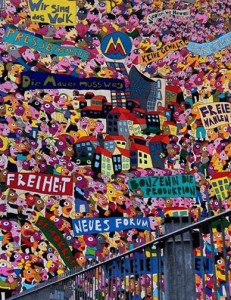 PhD proposals are invited on the following topics:
PhD proposals are invited on the following topics:
- the relationship between globalisation and the fall of state socialism;
- “1989” as a globally interconnected phenomenon;
- the global impact of the collapse of state socialism;
- the impact of the fall of state socialism on memory on a transnational, transregional or global scale;
- other innovative themes which place the fall of state socialism in global perspective.
Applicants wishing to work on any country, world region, or interconnections between regions, or on a global scale, are encouraged to apply. Proposals may address these themes from political, economic, cultural or social perspectives, and may draw their expertise from any discipline in the humanities or social sciences.
The successful candidate will be supervised by Professor James Mark, Principal Investigator with 1989 after 1989. The studentship is anticipated to start between May and September 2015 and is open to UK and EU applicants only. The award will cover tuition fees and provide an annual stipend of £13,863 for three years. More information on this PhD studentship and how to apply can be found on the University of Exeter’s PhD funding webpages.
In addition to this, a further PhD studentship is available on Professor James Mark‘s Arts and Humanities Research Council (AHRC) supported project Socialism Goes Global: Cold War Connections Between the ‘Second’ and ‘Third Worlds’ 1945-1991. This collaborative project brings together the Universities of Exeter, Oxford, Columbia, Leipzig and Belgrade, the Hungarian Academy of Sciences, and University College London to address the relationship between what were once called the ‘Second World’ (from the Soviet Union to the GDR) and the ‘Third World’ (from Latin America to Africa to Asia).
PhD proposals are invited on themes which address any political economic, cultural, or social aspect of this encounter, whether from the viewpoint of one region/country/ institution/group, or with a transregional approach incorporating the perspectives of multiple global actors. For an indication of some potential project areas, see the programme for the project’s first conference.
More information on Socialism Goes Global and how to apply can be found on the University of Exeter’s PhD funding webpages.
[Top]‘Death to fascism, freedom to expression!’ – The Post-Yugoslav Media and Freedom of Speech
Posted on 3 November, 2014 in1989 after 1989 End of Yugoslavia Human Rights

By Ljubica Spaskovska
The transition to democracy should have liberated the media in the former Yugoslav states, but in many ways the situation has actually gotten worse.
‘In these times/when everything is silent/In these times/I say – freedom/ And I see fear…’
This verse from the song entitled ‘Freedom’ is one of the tracks from an album by the Macedonian band ‘Reporters’ made up exclusively of journalists of different ethnic backgrounds. Under the slogan ‘Solidarity for freedom’, the Independent trade union of journalists and media workers, with the support of the US Embassy launched a campaign meant to incite a debate on freedom of speech, on the state of the media in Macedonia and solidarity among journalists. Over the past few weeks, both Macedonia’s and Serbia’s Independent Journalists’ Associations (members of the International Federation of Journalists) have raised concerns about similar phenomena through calls for a public hearing on media freedom or through the organisation of debates, conferences and concerts.
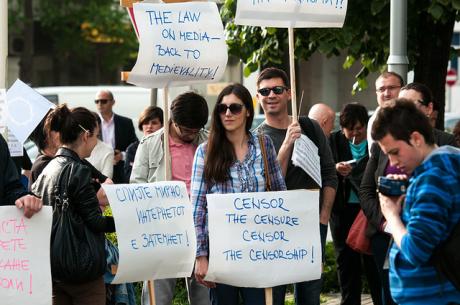
Indeed, the 2014 EU progress reports for all of the post-Yugoslav states aspiring to EU accession (Bosnia-Herzegovina, Montenegro, Serbia, Kosovo, Macedonia) underline a trend of serious deterioration of media freedom. Almost quarter of a century after the disintegration of Yugoslavia and the introduction of electoral, multi-party democracy, these societies have been witnessing a progressive narrowing down of public, intellectual and media spaces for free debate and reporting. Political and financial pressures, intimidation and threats against journalists and editors in Bosnia, self-censorship, threats and violence against journalists in Serbia, Montenegro and Kosovo, and government influence on media exercised through state-financed advertising in Macedonia have been observed in a context of a scarcity of real commitment on the part of political elites to tackle this problem and take the recommendations from the progress reports seriously.
Over the years, different governments have managed to blur the line between the ruling party/coalition and the state and to deprive state institutions of their independence. Moreover, they have turned an increasing number of media outlets into channels for dissemination of their political ideology or attacks on political opponents. For instance, the State Department Macedonia Country Report on Human Rights Practices for 2013 noted that members of the Association of Journalists of Macedonia reported pressures ‘to adopt a pro-government viewpoint in their reporting or lose their jobs.’
In Macedonia, further grievances were aroused by the detention and conviction of journalist Tomislav Kežarovski for revealing the identity of a protected witness in a story written in 2008. Civil society activists, local journalist associations and opposition leaders have constantly referred to reports by international bodies and governments that had condemned the trial and Kežarovski’s imprisonment in order to give legitimacy to their protest, albeit to little avail.
Moreover, the State Department Country Report lists Kežarovski’s case in the section entitled ‘Political Prisoners and Detainees’. The OSCE Representative for the Freedom of the Media, as well as the European Federation of Journalists similarly condemned the long sentence. Hence, it comes as no surprise that in the 2014 World Press Freedom Index Macedonia sits in 123rd place and has never been so low in the Index (the lowest in comparison to the other former Yugoslav states).
However, the state of the media is only a symptom of wider societal phenomena such as growing intolerance toward ‘oppositional’ voices and certain frozen narratives which seek to uncritically glorify the nation, the state, the ruling ideology and demonize the socialist/Yugoslav past. Croatia and Slovenia are the only two former Yugoslav republics which are members of the European Union. Although considerably higher on the World Press Freedom Index, neither Slovenia nor Croatia have been immune to the (re)establishment of a certain dogmatism in interpreting or discussing about the past.
A case in point is the recent decision of Croatian President Ivo Josipović to fire his main analyst professor Dejan Jović for an article in the academic journal Political Thought. Entitled ‘Only in myths every nation desires its own state’ and comparing the Scottish independence referendum and the Yugoslav referenda of the early 1990s, Jović argued that the latter were illiberal and did not allow for a genuine debate and consideration of all political opinions and visions for Yugoslavia’s future.
Similarly, the MPs of the conservative Slovenian Democratic Party (SDS) proposed a dismissal of the president of the Slovenian national assembly Dr. Milan Brglez for qualifying Yugoslavia in an interview as a state that had credibility and prestige in the international community and that the Slovenian independence in that sense was a step backwards.
Why, a quarter of a century after the first multi-party elections in the former Yugoslavia, are there still certain dogmatic ‘truths’ in most of the successor states, where freedom of expression is not an accomplishment, but, rather, something yet to be realised?
An obvious reason which is often evoked as the main factor is the socialist past itself. However, this can only offer a partial explanation and it could be counter-productive, as it fails to put the burden of responsibility on contemporary policy-makers and elites. Moreover, from 1950 practices of pre-censorship had been abolished in socialist Yugoslavia. It was the public prosecutor who could act only ex-post facto, after a broadcast, publication or film presentation. By the mid-1980s, the Yugoslav media network was significantly fragmented, decentralised, yet numerically impressive.
In 1987, Yugoslavia had 2,825 newspapers and 202 radio and TV stations. Hence, it was virtually impossible to sanction all acts which were classified as ‘verbal crime’ under the notorious ‘Article 133’ which criminalised acts of ‘hostile propaganda’, but was also meant to curb nationalist discourse, channelling what Lenard Cohen identified as ‘Yugoslav communism’s strong antipathy to overt nationalist tactics’.[1] Moreover, the 1980s saw the reinvigoration of the debate on freedom of speech and on the abolishment of the verbal crime. Although restrained, debate did occur in different fora.
For instance, in 1981 the president of the Federal Court in an article in a law journal acknowledged that the formulation of ‘Article 133’ was not precise, while at the 1983 conference of Yugoslav criminologists several professors of law called for the repeal of the article.[2] Several years later, as a young journalist in one of the principal magazines of the League of Socialist Youth, Dejan Jovic argued that the organisation (which in fact financed the magazine) should be abolished [3]. Back then, he was not sacked for his opinion.
Twenty-five years later, both old and new generations of journalists, intellectuals, students and activists are fighting battles which would have normally belonged to a distant past. When on 9 May last year, on the occasion of Europe Day, representatives of the ‘Front for Freedom of Expression’ gathering a number of civil society organizations and initiatives staged a protest in front of the seat of the delegation of the European Union to Macedonia, they chose as their slogan a creative remake of an old motto of the partisan resistance movement: ‘Death to fascism, freedom to expression!’.
References:
[1] Lenard Cohen, The Socialist Pyramid Elites and Power in Yugoslavia(Oakville/New York/London: Mosaic Press, 1989), p.445.
[2] Yugoslavia: Prisoners of Conscience (London: Amnesty International Publications, 1985), p.29.
[3] Dejan Jović, ‘Kad bi SSOJ postojao, trebalo bi ga ukinuti (1)’ Polet 402, 10.2.1989.
[Top]Writing Human Rights into the History of State Socialism
Posted on 24 March, 2014 in1989 after 1989 Human Rights

By Ned Richardson-Little

One of a number of East German postage stamps commemorating International Human Rights Year 1968. The hammer and anvil represent the right to work
The collapse of the Communist Bloc in 1989-1991 is viewed as one of the great triumphs of the human rights movement. But this ignores how socialist elites of the Eastern Bloc viewed themselves: not as the villains in the story of human rights, but as the champions.
In recent years, the rapidly expanding field of human rights history has done much to complicate triumphalist narratives of inevitable victory for Western liberal democracy over the forces of tyranny. Recent collections including those edited by Stefan-Ludwig Hoffmann, Jan Eckel and Samuel Moyn, have opened up new lines of inquiry exposing not only the contingency of these ideas, but also the conflicts amongst those claiming the mantle of universal human rights. On the Exeter University Imperial and Global History Centre blog in recent weeks, Fabian Klose has examined the important role of decolonization and post-colonial states in shaping the development of human rights politics, and Robert Brier has interrogated the idea of human rights as a product of neo-liberalism in the context of the Polish opposition. Here, I want to look beyond the human rights campaigns of dissident Eastern Europeans to that of the states they fought against.
While state socialism is normally seen as the definitional opponent of human rights – rejecting individual autonomy, independent justice, free elections, free speech and free practice of religion – the elites of the Eastern Bloc claimed that they were actually the true representatives of human rights. For them, the revolutionary victory over capitalism meant the end of class conflict and the abolition of the “exploitation of man by man.” The creation of a socialist society overcame the horrific abuses of the capitalist system, including war, imperialism and racism.
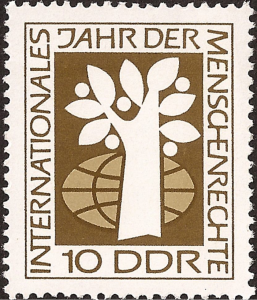
Another stamp commemorating International Human Rights Year 1968. The tree and globe represent the right to life
Eastern Bloc elites built upon Karl Marx’s denunciation of human rights rhetoric as a tool of the bourgeoisie to disguise their own class interests in the cloak of universal justice. They argued that while human rights were indeed a sham under capitalism, the socialist revolution had created a higher kind of human rights that allowed for real participation in all forms of political and economic life and achieved true equality across the class, race and gender lines. As the East German legal philosopher Karl Polak declared, “There can be no human rights without socialism!”[1]
When such rhetoric from the Eastern Bloc has been noted in histories of the Cold War, it is usually dismissed as a crude and cynical attempt to deflect Western criticism, particularly after the signing of the Helsinki Accords in 1975. That is, once the communist states were compelled to affirm the idea of human rights, they simply had to adjust their rhetoric in a desperate attempt to fend off protest from within and without.[2] These narratives are undermined, however, by the fact that state socialist elites were using the language of human rights well before Helsinki – the quote above from Karl Polak dates to 1946. In Hungary, the first scholarly work on human rights and socialism was written by legal scholar Imre Szabo in 1948.[3] As Jennifer Amos and Daniel Whelan have demonstrated, the Soviet Union was an active player in the human rights diplomacy of the 1950s. Such early efforts weren’t just rhetorical or academic: the German Democratic Republic formed the Committee for the Protection of Human Rights to campaign against abuses by the West and to mobilize citizens to campaign against the imprisonment of communists and peace activists in West Germany. Founded in 1959, this group predates the creation of Amnesty International by two years.
The 1970s are today seen as the turning point when international human rights exploded as a global movement, but at the beginning of the decade, it appeared to some observers that the West was simply outmatched by the Socialist Bloc. By 1968, the entirety of the Eastern Bloc had either signed or publically affirmed the UN’s International Covenant on Civil and Political Rights. While the United Kingdom, Italy, and West Germany did so early on, other Western countries lagged well behind with Canada signing in 1976, the USA in 1977 and France in 1980. In 1973, one observer from West Germany concluded,
With the change in majorities in the bodies of world organizations – particularly in the [UN] General Assembly – the socialist states have recognized the possibility of the politicization of human rights, and the free world has almost cleared off the field without a fight: the US by its human rights abstinence, the Western European countries by their regionalism.[4]
While the Helsinki Accords are now often portrayed as a coup for the West in “forcing” the East to accept terms that would eventually lead to its downfall, at the time, the idea of human rights was hardly seen as a devastating ideological weapon.
Including the perspective of state socialist leaders and elites is crucial to understanding human rights diplomacy in the post-war era. Such ideas and politics also were crucial to state socialist rule and influenced the development of dissident and opposition movements, as I have recently argued, along with Benjamin Nathans, Paul Betts, and Mark Smith and others. Celia Donert’s recent work similarly demonstrates how the explosion of women’s rights as human rights in 1990s can be in part traced back to the transnational feminism organized through Eastern Bloc organizations and events that have been dismissed as mere propaganda for communism. Rather than simply seeing the rise of human rights movements in the East as a direct importation from the West, this new scholarship shows how 1989 was also connected to the evolution of indigenous right cultures that were initially fostered by the state. This line of inquiry is not only valuable to the study of the Cold War and its end, but also to explaining the development of human rights politics in the post-socialist period.
In challenging liberal Western triumphalism, it is also vital to consider the perspectives of the socialist East. The appropriation of the idea of human rights by non-liberal and even dictatorial states is no relic of Cold War dynamics long since departed, but is continuing to this day in Iran and North Korea. In grappling with the developments of 1989, political scientist Peter Juliver argued that one had to begin a process of “rethinking rights without the enemy.” I would argue that in order to do so, we first must rethink the history of human rights including the “enemies,” and not just the victors.
[1] Karl Polak, “Gewaltteilung, Menschenrechte, Rechtsstaat: Begriffsformalismus und Demokratie,” Einheit 7 (December 1946): 138.
[2] For the main work asserting the discontinuous effect of Helsinki Accords for the Eastern Bloc, see Daniel Thomas, The Helsinki Effect: International Norms, Human Rights, and the Demise of Communism(Princeton UP, 2001) as well as Michael Ignatieff, Human Rights as Politics and Idolatry, University Center for Human Values series (Princeton UP, 2001), 19, which argues that the Eastern Bloc denied the validity of political and civil human rights prior to Helsinki.






